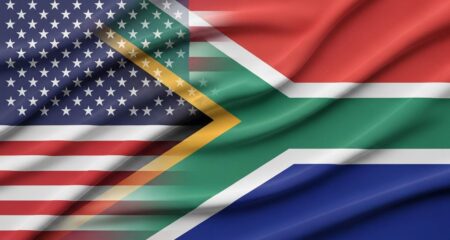
The South African Reserve Bank left borrowing costs unchanged for a fourth consecutive meeting as it projects the inflation rate will fall back to within its target and the economy is set to expand at the slowest pace since a recession six years ago.
The central bank left the benchmark repurchase rate at 7%, governor Lesetja Kganyago told reporters Thursday in the capital, Pretoria. All 19 economists surveyed by Bloomberg forecast borrowing costs would stay unchanged.
The Monetary Policy Committee has kept the key lending rate on hold since March after raising it by 200 basis points since 2014 in a bid to limit price growth in an economy that’s strained by a drought, weak demand in its main export partners and domestic and international political uncertainty. Slow economic growth is one of the key factors that rating companies like Moody’s Investors Services, which will publish its assessment of the nation’s creditworthiness on Friday, have highlighted as risks.
Given the policy tightening it’s done, “the Reserve Bank could afford to pause and leave rates unchanged in the short-term”, Kevin Lings, chief economist at Stanlib Asset Management, said in an e-mailed note to clients before the decision. “However, the outlook for South African interest rates will be significantly impacted by any further adjustment to US interest rates as well as the likelihood of South Africa’s credit rating being revised lower.”
The rand slid the most in five years after Donald Trump was elected president on fears his spending plans could fuel US inflation and accelerate Federal Reserve rate increases. That boosted South African price expectations and stoked investors’ bets that domestic borrowing costs will have to climb. A decision by South Africa’s chief prosecutor to charge finance minister Pravin Gordhan with fraud — before dropping the case three weeks later — contributed to the currency’s volatility.
While inflation quickened to an eight-month high of 6,4% in October as food prices surged by 12% from a year ago, price growth is projected to slow to within the central bank’s 3-6% target band by the second quarter of next year, Kganyago said. The MPC forecasts average inflation of 5,8% for next year and 5,5% for 2018.
“The MPC remains concerned that the inflation trajectory is uncomfortably close to the upper end of the target range,” he said. “While the committee retains the view that we may be close to end of the hiking cycle, there may be a reassessment of this position should the upside risks transpire.”
Moody’s rates South Africa’s foreign currency debt at two levels above junk, with a negative outlook, and S&P Global Ratings, which will publish its review on 2 December, has the nation on the lowest investment-grade level, with a negative outlook. Officials from Fitch Ratings, which has a stable outlook on its BBB- rating and hasn’t set a date for its assessment, visited South Africa last week.
The rand will remain sensitive to a possible credit-rating downgrade, Kganyago said.
The currency weakened 0,6% to R14,24/US$ by 3.27pm in Johannesburg on Thursday. Yields on rand-denominated government bonds due December 2026 rose three basis points to 9,03%. — (c) 2016 Bloomberg LP




